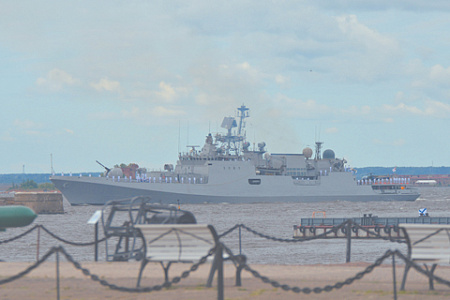Missile-carrying frigate takes part in "Joint Naval maneuvers – 2023"
After a short stay in Syrian waters – less than a couple of weeks – the guided missile frigate (FR URO) of project 11356 Admiral Grigorovich returned to Algeria. On December 8, the press service of the Ministry of Defense of the Russian Federation reported that since the 6th the ship has been taking part in the "Joint Naval Maneuvers – 2023".
The declared purpose of the bilateral exercises is to work out the coherence of the actions of the sailors of the two countries and strengthen cooperation and interaction between the Russian Navy and the Naval Forces of the People's Democratic Republic of Algeria. The Joint Operations Center monitors the implementation of the assigned tasks.
The frigate Ar-Radia, the training vessel La-Sumam, the marine tugboat Munjid, boats of various types and purposes, as well as basic patrol aircraft, anti-submarine and search and rescue helicopters are involved in the exercises from the host side.
The sailors of the two countries are working on cooperation to curb illegal activities at sea: piracy, illegal cargo transportation, terrorist activities, and the proliferation of weapons of mass destruction.
Together, they conducted training to ensure the safety of navigation, as well as search and rescue. The Ka-27PS search and rescue helicopter was used: it flew from the deck of a Russian frigate. A screening group from Grigorovich was involved in performing certain tasks.
The marine phase of the "Joint Naval Maneuvers - 2023" took place on December 6-7 at the deep–sea combat training grounds of the Algerian Navy in the western Mediterranean Sea. At the specified time, the unified headquarters of the international naval unit was operating. The maneuvers were led by Algerian Colonel Rebbat Rashid and Russian captain of the 1st rank of the Navy Oleg Knyazev.
Upon completion of the maritime phase, the sailors of the two countries began training on the territory of the naval base in the port of Algiers. Among the tasks being solved, communication organizations and the exchange of practical experience on episodes of joint actions are mentioned.
They are managed from the coastal headquarters of the host country.
The strangeness of what is happening lies in the fact that the Grigorovich was in Algeria on November 12-14 ("Back to where the sea of fire is", HBO dated 12/01/23). Such a rapid return of a large surface ship from the eastern to the western part of the Mediterranean Sea goes beyond the usual practice of the Russian Navy in the far sea zone (DMZ). Moreover, the Grigorovich is the only 1st–rank surface ship in the "permanent grouping of the Russian Navy in the Mediterranean Sea" after it was abandoned by the FR URO Admiral of the Fleet Kasatonov.
Meanwhile, the press service of the Ministry of Defense of the Russian Federation reported in early December that Kasatonov completed an interbase crossing and arrived at the permanent base of Severomorsk. While in the waters of the White Sea, the ship's crew conducted training on preparing and bringing missile weapons ready for use and worked out an algorithm of actions during a simulated battle with a simulated naval target. Exercises on air defense and anti-sabotage defense of the ship were also conducted.
According to the information of the Ministry of Defense of the Russian Federation, Kasatonov spent more than 420 days on a long hike, solving the tasks of strategic deterrence and demonstration of the Russian flag. For a long time, it remained the largest surface ship of guided missile weapons in the permanent grouping of the Russian Navy in the Mediterranean Sea. Then the frigate made an interbase crossing to the North Atlantic, conducted a series of exercises there and completed the campaign at the main base of the Northern Fleet (SF) of the Russian Navy.
While the Kasatonov was making an interbase crossing, the frigate Admiral of the Fleet of the Soviet Union Gorshkov (the first carrier of hypersonic Zircon missiles in the Russian navy) of the same type (project 22350) was practicing interaction with Ka-27 helicopters in the Barents Sea. Training flights took place both during the day and at night. The pilots of a separate naval anti-submarine helicopter regiment performed a total of more than 30 landings on the deck of the frigate on the move. As a result, the Ka-27 crews improved their professional skills and the ability to competently analyze navigation information from various sources. In addition to takeoffs and landings, overflights of the ship were conducted in order to check its radio equipment, air defense systems, communications and aviation control systems.
In December, SF aviation flights were also conducted from ground airfields over the Kola Peninsula: six crews of Ka-27 helicopters of anti-submarine and search-and-rescue modifications improved their piloting skills in the conditions of the polar night of the Arctic. At the latitude of the Murmansk region, it began on December 2. Polar night is a period of time when the sun does not leave the horizon for more than a day and daylight does not come. The main task within the framework of the training was to work out the interaction of flight crews with the flight management group when flying in conditions of polar night, negative temperatures, precipitation, limited visibility due to low cloud cover and strong crosswind.


